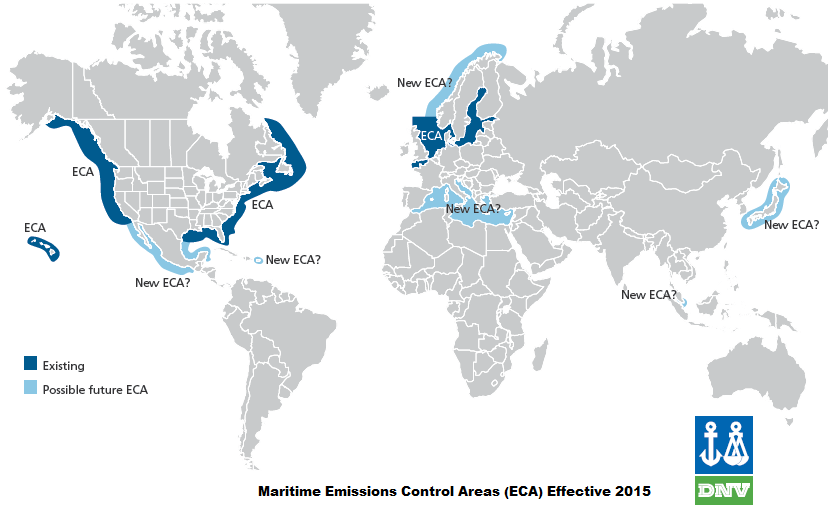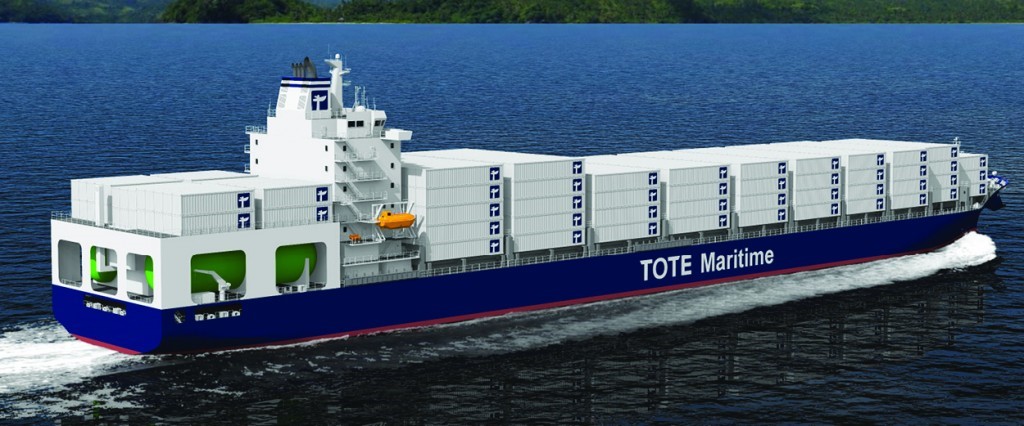Published at FC Gas Intelligence, Oct. 14, 2014
Commissioner William P. Doyle of the U.S. Federal Maritime Commission spoke recently at the North American Gas Forum on the expanding role of LNG as a marine fuel. There are two primary drivers that are causing this expansion of maritime LNG use, low cost natural gas now available from hydrofracking shale in North America and new emissions rules limiting the amount of sulfur pollution from ships.
New emissions rules are being put into place in the USA and Europe that restrict the amount of sulfur pollution from ships in coastal areas. These new rules, known as MARPOL Annex VI, were developed through the UN and resulted in the formation of Emissions Control Area (ECA) zones of North America and Northern Europe (including the Baltic Sea, North Sea and English Channel). The maximum sulfur content in the ECA zones will be reduced from 1 percent to 0.1 percent, effective January 1, 2015.
When traveling through ECA zones ship operators will be required to switch fuels from conventional bunker fuel to more expensive low-sulfur distillate fuels such as marine gas oil (MGO) or install expensive exhaust scrubbers similar to those on coal fired power plants. The alternative option is to use LNG as a fuel. There has been some concern that the January 1, 2015 timetable is too aggressive and that scrubbers and LNG cannot be readily deployed in time. More rules are coming though, for waters outside the ECAs sulfur content will be cut to 0.5 percent in 2020.
Marine shipping is the most serious source of pollution from all transportation sectors and has major impacts on coastal communities and global health. The pollution largely results from the low grade heavy fuel oil that is burned in enormous engines. Switching to LNG would lead to dramatic reductions of sulfur oxides (SOx) by 90%-99%, reduced nitrogen oxides (NOx) by up to 90%, reduced CO2 emissions by 25% and nearly 100% reduced particulate emissions.
The shipping industry is taking the new emissions rules seriously, but much work remains to be done to make LNG marine fuel a reality. The Trident Alliance was formed in July, 2014 as an organization of international ship owners and operators who are committed to robust enforcement of maritime sulfur regulations and includes leading carriers such as Maersk. In North America, the US Coast Guard and Environmental Protection Agency have been actively testing smokestack plumes and bunker fuel receipts. According to the Trident Alliance, “robust enforcement of sulfur regulation is needed for health and the environment and, from the perspective of maintaining a level playing field, it is a business imperative”.
LNG is projected to be much less costly than marine gas oil (MGO) which will be the required fuel for ships in ECA zones if scrubbers are not used. Currently, LNG for trucks costs around $1.70 per gasoline gallon equivalent, compared to $3.42 for gasoline and $3.78 for diesel, MGO is a similar distillate to low sulfur diesel. But ships do not purchase fuel by the gallon, they purchase it by the ton and burn tons per hour. MGO currently costs roughly $300 more per ton than conventional heavy fuel oil (HFO). It is estimated by the International Chamber of Shipping that running MGO will cost the industry $50 billion a year. LNG on the other hand would reduce fuel costs significantly over heavy fuel oil.
The difficulty in utilizing LNG is that there is a very limited number of ships currently available that have LNG engines and also very few LNG bunkering facilities for ships to fuel up. These infrastructure hurdles are the biggest challenge the LNG industry needs to overcome for wide acceptance. The U.S. is moving forward with construction of offshore supply-vessels, ocean-going LNG fueled ships and bunkering operations.
New Orleans based Harvey Gulf International Marine announced they would be building six U.S. flagged offshore vessels fueled by domestic LNG. Harvey Gulf estimates they could save up to $2.4 million per ship per year on fuel costs. TOTE Shipping recently announced they are constructing two new LNG powered vessels to operate between Florida and Puerto Rico. TOTE is also converting two of its container ships that operate between Tacoma, Washington and Alaska to LNG.
Aker Philadelphia Shipyard is building eight LNG-ready product tankers and LNG-ready container ships. And on the West Coast, General Dynamics NASSCO shipyard has contracts and options to construct seven LNG conversion-ready U.S. flagged tankers. Kinder Morgan Energy Partners, a major pipeline and energy storage company, entered the U.S.-flag Jones Act tanker market and announced it would build an LNG conversion-ready tanker at NASSCO.
Bunkering facilities are needed to fuel these ships are efforts are being made to combine LNG export facilities with bunkering operations. LNG America has partnered with Cheniere Energy to secure LNG from the Sabine Pass LNG export facility under construction in Cameron Parish, Louisiana. The company recently announced that it selected Taylor-Wharton to commence the engineering and design work for the 3,000 cubic meter Gemini Class LNG bunker barge scheduled for delivery at the end of 2015.
The Obama Administration fully supports the use of natural gas as a marine fuel. The U.S. Transportation Department approved a $324.6 million Title XI loan guarantee to TOTE for financing the construction of their two LNG fueled container ships. And the U.S. Maritime Administration (MARAD) awarded $400,000 to the Great Lakes Maritime Research Institute (GLMRI) to research LNG as an alternative fuel on the Great Lakes. MARAD recently published a study, conducted with DNV GL, on the needs for LNG bunkering.
There is no one solution for LNG bunkering as infrastructure is highly dependent on the needs of specific ports and stakeholders. The options for bunkering include truck to ship, shore to ship, ship to ship, and portable tank transfer. Safety issues are also very important and safety zones and hazard distances must be established. There are significant regulatory gaps that also still need to be addressed. Uniform standards and guidelines for state and local lawmakers are needed for a consistent and predictable regulatory framework.
While much work needs to be done, there is much promise in the use of LNG as a marine fuel. The environmental advantages are crystal clear, emissions of sulfur and particulates and essentially eliminated, nitrogen oxides are dramatically reduced and so are CO2 emissions. Assuming natural gas production remains high and prices low then the incentives will remain for ship owners and regulators to continue the transition to LNG fuel.

